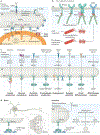Mechanisms, regulation and functions of the unfolded protein response
- PMID: 32457508
- PMCID: PMC8867924
- DOI: 10.1038/s41580-020-0250-z
Mechanisms, regulation and functions of the unfolded protein response
Abstract
Cellular stress induced by the abnormal accumulation of unfolded or misfolded proteins at the endoplasmic reticulum (ER) is emerging as a possible driver of human diseases, including cancer, diabetes, obesity and neurodegeneration. ER proteostasis surveillance is mediated by the unfolded protein response (UPR), a signal transduction pathway that senses the fidelity of protein folding in the ER lumen. The UPR transmits information about protein folding status to the nucleus and cytosol to adjust the protein folding capacity of the cell or, in the event of chronic damage, induce apoptotic cell death. Recent advances in the understanding of the regulation of UPR signalling and its implications in the pathophysiology of disease might open new therapeutic avenues.
Conflict of interest statement
Competing interests: The authors declare no competing interests.
Figures





References
-
- Hebert DN & Molinari M In and out of the ER: protein folding, quality control, degradation, and related human diseases. Physiol. Rev 87, 1377–1408 (2007). - PubMed
-
- Balch WE, Morimoto RI, Dillin A & Kelly JW Adapting proteostasis for disease intervention. Science 319, 916–919 (2008). - PubMed
-
- Ron D & Walter P Signal integration in the endoplasmic reticulum unfolded protein response. Nat. Rev. Mol. Cell Biol 8, 519–529 (2007). - PubMed
-
- Dever TE et al. Phosphorylation of initiation factor 2 alpha by protein kinase GCN2 mediates gene-specific translational control of GCN4 in yeast. Cell 68, 585–596 (1992). - PubMed
Publication types
MeSH terms
Substances
Grants and funding
LinkOut - more resources
Full Text Sources
Other Literature Sources

